Effect of foot and mouth disease vaccination on seminal antioxidant profiles of mithun(Bos frontalis)
P. Perumal
Animal Reproduction Laboratory, ICAR-National Research Centre on Mithun, Medziphema, Nagaland-797 106, India
Keywords:Antioxidants profiles Foot and mouth disease vaccination Mithun Oxidative profile
ABSTRACT Objective: To assess the deleterious effects of foot and mouth disease vaccination on antioxidant profiles as well as oxidative stress in the semen of breeding mithun bulls. Methods: A total of 160 semen samples were collected from 8 adult healthy mithun bulls with good body condition score (5-6), which were maintained at semen collection centre, ICAR-National Research Centre on Mithun, Medziphema, Nagaland, India, twice a week, 4 weeks before vaccination (pre-vaccination stage) and 12 weeks after vaccination (post-vaccination stage)to understand and know the influence of vaccine stress on seminal antioxidant as well as oxidative stress profiles in mithun. Vaccine was injected at the end of week 4 and semen samples were collected & analysed up to week 16 of the investigation period. Results: Data analysis showed that foot and mouth disease vaccination has significantly (P<0.05) altered the seminal antioxidant, biochemical and oxidative stress profiles up to week 10th of vaccine administration. However, the immunised bulls were recovered in physical health status, semen production and its antioxidant profiles gradually. Conclusions: The results of the present study suggest that the semen sample collection as well as preservation should to be suspended up to week 10th of post immunization to get antioxidant and biochemical profiles in normal level in the semen to preserve normal conception rate in artificial breeding programme by using such semen in mithun species.
1. Introduction
Mithun (Bos frontalis) is a unique, domesticated, free-range mountain cattle species maintained under extensive or semi-intensive management system in North Eastern Hilly (NEH) states, Nagaland,Manipur, Mizoram and Arunachal Pradesh of India, and is revealed to be originated from wild Indian gaur[1]. The species is not yet under endangered animal species; however, it is affected from severe and serious non-cyclical fluctuations of population on the local/national/regional basis as per the report of the livestock censuses of Government of India, due to various factors such as lack of good quality breeding bulls and lack of proper breeding management,etc.Further, it is also said that mithun plays key roles in the economic,social, cultural and religious life of the mithun rearing tribals[2]. In recent time, mithun is considered as an important beef animal in NEH region and entered into the modern animal husbandry programmes;therefore, it is needed to initiate and popularize this species for economic meat production as NEH region is significantly higher meat eater than national average. Hence, it is needed to grow under well planned semi-intensive or intensive system like domestic cattle or buffaloes or other domestic livestock species with introduction of latest assisted reproduction technologies as well as controlled breeding programmes in this species. Therefore, it is important and necessary to format suitable and effective semen collection,preservation and breeding programmes to this precious species breed improvement and conservation in NEH region.
In NEH region of Indian sub-continent, as in other bovine &bubaline species, mithun species is managed in semi-intensive or extensive free-range system along with bovine & bubaline species,suffers with different infectious, contagious and zoonotic viral,bacterial fungal and parasitic diseases such as para-tuberculosis ,tuberculosis, foot and mouth disease (FMD), brucellosis, bovine viral diarrhoea and infectious bovine rhinotracheitis[3], which in turn cause severe and serious morbidity and detrimental effects on economy of mithun husbandry practices. Mithun is mainly affected severely with FMD[4,5] with Pan Asia I[6], O strain[7] and type Asia-1 strains[5] than other bovines such as cattle and bubaline species like riverine & swamp buffaloes in this NEH region of India. Frequent and severe outbreaks of FMD were reported in mithun in mithun rearing regions[5,8].
In general, the breeding mithun bulls are immunized against FMD as a routine and regular prophylactic measurement to control and prevent this deleterious disease incidence. Earlier various reports revealed that vaccination against different diseases had severe and deleterious effects on semen production, its quality and biochemical & antioxidant profiles in livestock species[9-13].However, proper and systematic reports were not present for mithun species mainly on FMD vaccination effect on seminal antioxidant and oxidative stress attributes in mithun. Based on the previous reports available on vaccination effect on semen production and its antioxidant & oxidative stress profiles in cattle, the results were conflicting with each other. Some reports indicated that vaccination had not significantly affected on production of semen and its quality profiles[9], while on the other hand, it had reported that it considerably increased the total abnormal sperm percentage[10].The harmful effects caused by immunization on the semen quality parameters are due to immunization/vaccination stress and also shock due to anaphylactic reactions[11], because it leads to higher body and testicular temperature. However, recovery rate on semen quality parameters and health status of animals is depending upon the degree, nature and length of duration of exposure of thermal insult.
Higher quantity of polyunsatured fatty acids in mammalian sperm membrane renders the sperm susceptible to lipid peroxidation(LPO), resulting in alteration of sperm total motility & velocity and membrane integrity, mitochondrial membrane potential, damage to DNA of sperm and finally fertilization failure[14]. Production rate of free radicals or reactive oxygen species (ROS) in the gonad and/or germ cells is appeared to be thermo sensitive or temperature dependent[15] as vaccination-induced thermo stress results in deterioration of semen quality parameters and its antioxidant profiles.Therefore, the antioxidant profiles are very critical and important for reproductive system of male as well as for spermatogenesis and are needed to guard against oxidative injury or oxidative stress.Antioxidants such as glutathione (GSH), glutathione peroxidase(GPX), glutathione reductase (GRD), catalase (CAT), superoxide dismutase (SOD), melatonin, vitamin C and vitamin E are the major antioxidants available naturally in mammalian semen to protect the sperm against ROS and to maintain its integrity to get higher fertilization rate[16-20]. However, these antioxidants concentration are decreased in immunized animals may be due to thermal stress as well as anaphylactic shock[21]. Because these antioxidants are secreted by epididymis[22,23] and seminal vesicle[24] into the semen stream, accessory sex glands and epididymis are androgen dependent and thermo sensitive[25]. Further, the thermal stress due to vaccination has considerable effects on the GSH oxidizingreducing cycle in sperm as well as in seminal plasma[21]. Therefore,external antioxidants in feed or subcutaneous implant or additives in the extender are very much helpful to protect the sperm from ROS in semen preservation[26-28]. Based on the fact, the present investigation was planned to assess the FMD vaccination effects on seminal antioxidants and oxidative stress profile level in semen of mithun.
2. Materials and methods
2.1. Animals and semen collection
Healthy adult mithun bulls (n=8) of 4-6 years of age with good body condition (score 5-6) were selected from semen collection centre, ICAR-National Research Centre on Mithun, Medziphema,Nagaland, India for the present investigation and they were maintained with homogeneous feeding, housing and other managemental conditions. These experimental bulls were fed daily ad libitum clean, hygiene drinking water and mixed jungle forages at 30 kg (contains crude protein: 10.2%, dry matter: 18.4%) and concentrates at 4 kg (contains dry matter: 87.1%, crude protein:14.5%) and enriched with standard good quality mineral mixture &salt. Ejaculates were collected using trans-rectal massage procedure twice per week during the experimental periodi.e.pre-and post vaccination. FMD vaccine was administered at the end of 4th week and ejaculates were collected and evaluated for pre and post vaccination up to week 16 to assess the influence of vaccination,if any in semen antioxidant profiles. In short, the accessory gland,seminal vesicles were massaged backwardly and centrally for at least 5 min and slowly gentle milking of ampullae for 3-5 min,which resulted into penile erection and semen ejaculation. FMD vaccine, Raksha-Ovac (trivalent, containing virus types O, A and Asia 1-strains, Indian Immunological Ltd., India) was injected at 2.0 mL by deep intra-muscular route. Semen ejaculates were allowed to evaluate the antioxidant profiles such as GSH, GRD, GPX, SOD,CAT, total antioxidant capacity (TAC) and biochemical profiles such as total cholesterol (TCh) were by commercial diagnostic kits and LPO (malondialdehyde; MDA) level was estimated by determining the MDA production using thiobarbituric acid method as described by Buege and Aust[29] and modified as per Suleimanet al[30]. During the investigation, all the experimental procedures complied with the Institutional Animal Care and Ethical Committee Regulations.The investigation was approved by Institutional Animal Care and Ethical Committee (IAEC; Registration No.: 267/GO/CB/2000/CPCSEA), ICAR-NRC on Mithun, Medziphema, Nagaland, India on 20/03/2015.
2.2. Statistical analysis
The data was statistically analysed and presented as the Mean± SEM in graphical form from week 1 to 16 of the experiment.Means were analyzed by student “t” test between the pre and post vaccination using the SPSS/PC computer program (version 15.0;SPSS, Chicago, IL).
3. Results
FMD vaccination effects on different seminal antioxidant, oxidative and biochemical profiles were estimated at weekly interval, 4 weeks pre-vaccination and 12 weeks post vaccination in breeding mithun bulls. Result revealed that FMD vaccination has significantly(P<0.05) altered the seminal antioxidant and oxidative profiles up to week 10th of vaccine administration. Peak effects were observed during the period of week 4-5th of vaccination (week 9-10th of experimental period) and return to normal level at 10th week of vaccination (15-16th week of the experimental period).The antioxidant profiles such as GPX (Figure 1), CAT (Figure 1),SOD (Figure 1), GSH (Figure 2), GRD (Figure 3), TAC (Figure 3), and glucose-6-phosphate dehydrogenase (G6PDH) (Figure 2)were significantly (P<0.05) decreased to minimum at 4-5 weeks of vaccination and then gradually increased to become normal at week 10th of post vaccination. In contrast, the TCh (Figure 3), and MDA/LPO (Figure 1) were significantly (P<0.05) increased at highest level at 4-5 weeks of post vaccination and decreased gradually to normal level at week 10th of post vaccination. Rectal temperature(Figure 4) was significantly (P<0.05) increased to the highest level at the 2-3 weeks of post vaccination and gradually decreased to normal level at week 10th of post vaccination. However, the immunised bulls were recovered in physical health status, semen production and its antioxidant profiles gradually at week 10th of post vaccination.The results of the present study suggested that the semen sample collection as well as preservation should to be suspended up to week 10th of post immunization to get antioxidant profiles in normal level in the semen to preserve normal conception rate in artificial breeding programme by using such semen in mithun species.
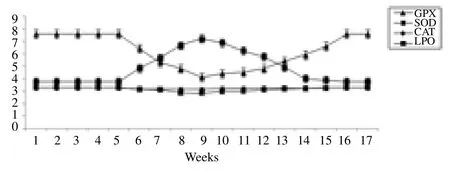
Figure 1. Effect of FMD vaccination on GPX (U/mL), SOD (U/mL), CAT(µg/mL) and LPO (nM/108 sperm) of mithun semen.
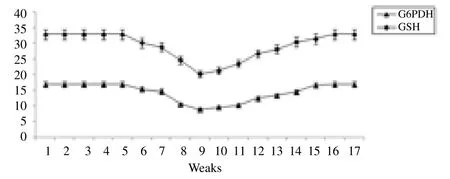
Figure 2. Effect of FMD vaccination on G6PDH (mU/mL) and GSH (µM/mL)of mithun semen.
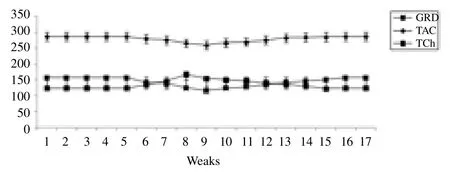
Figure 3. Effect of FMD vaccination on GRD (U/mL), TAC (µmol/L) and TCh (mg/dL) of mithun semen.
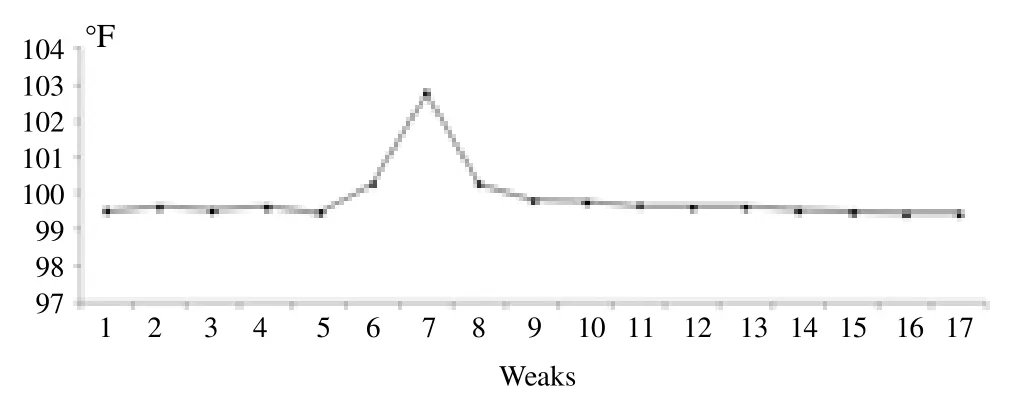
Figure 4. Effect of FMD vaccination on rectal temperature (°F) of mithun.
4. Discussion
Statistical analysis in the present study indicated that vaccination showed a significant (P<0.05) effect on the antioxidant, biochemical and oxidative profiles and significantly (P<0.05) increased ROS production in mithun semen, thus it adversely affected the structures as well as functional integrity of the spermatozoa. Therefore, the ejaculates from FMD vaccinated animals are not advisable to preserve for breeding programmes for certain period of time.
Based on the literature study, effect of FMD vaccination on antioxidant profiles and ROS production in mithun semen on weekly basis is not available and this is the first report on effect of vaccination on these profiles in mithun species. In the present investigation, FMD vaccination has shown a significant (P<0.05)difference between pre- and post-vaccinated stages in mithun bulls on antioxidative and oxidative parameters. These deleterious effects of vaccination in semen are due to increase of the temperature of body, in particular gonads & accessory sex glands, because it crossly affects the structural and functional aspects of seminiferous tubule vacuoles as well as reduced weight of the testis or hypotrophy of testis[31]. Anaphylactic shock or stress caused by vaccination leads to a significant (P<0.05) increase of temperature of body and testes, which in turn causes structural and functional derangement of epididymis and also affects the spermatogenesis process[32];this could result in vaccination-induced decreasing of semen quality parameters as similar characters were observed in testicular hypoplasia or in testicular degeneration[33].
Thermal stress induced by vaccination makes the animal unable to take in sufficient poly unsaturated fatty acids in their diet,which subsequently alters the spermatogenesis and membrane transition[34]. Vaccination has raised overflow in blood circulation of the testis, increased the testicular temperature up to 42°℃-43 ℃, and subsequently led to local heating[35]; insufficient oxygenation and hypoxic stress to the gonads resulted in increased ROS formation,leaded to failure of spermatogenic cell cycle and programmed cell death or apoptosis[36], brought about depletion of germ cells[37] and its functional activity[38], and finally had deleterious effects on the semen production, its quality profiles and fertilizing ability of the spermatozoa or breeding bulls.
Sperm membrane of mammalian species contain high concentration of polyunsatured fatty acids rendering the sperm susceptible to peroxidation, which significantly causes alters to the motility &velocity and membrane integrity of the sperm, because oxidation stress alters the phase transition, composition of cholesterol and phospholipid and its ratio of sperm membrane and also induces sperm DNA damage[14,26,27], which severely has influences on the fertility of breeding mithun bulls. Therefore, it is critical for the reproductive system of male and the sperm production system of gonad to be well protected against oxidative stress or injury.Mammalian semen contains GSH, GPX, GRD, CAT, SOD, vitamin C and vitamin E which are most important antioxidants to protect the sperm against ROS as well as from LPO to preserve integrity of sperm efficiently[16-20]. However, FMD vaccination stimulates fever or febrile condition to the somatic body and also to the reproductive system. The production rate of free radicals in the male gonads or spermatozoa is depending upon the degree of temperature and duration of time[15], and vaccination-induced thermo stress in turn causes the sperm quality to be deteriorated and fertilizing ability of breeding bulls to be impaired. Moreover, the concentration of these antioxidants is reduced due to anaphylactic shock and thermal stress in the immunized bulls[21] as these antioxidants are derived from epididymis[22,23] especially cauda epididymis and seminal vesicle[24] into the semen stream and epididymis & seminal vesicles are sensitive to heat stress and testosterone dependent[25]. Earlier reports suggested that thermo stress causes gross dysfunction of the endocrinological system of testes due to thermo stress leading to drastic decrease in number of the luteinizing hormone receptors[39]and reduction of gonadotropin uptake[40] in the gonad. Moreover, the functional enzymes associated with biosynthesis of androgen[41] and synthesis of androgen-binding protein[42] have been decreased in the affected (vaccinated or thermo stressed) mithun bulls.
Vaccination induced thermal stress and anaphylactic stresses have increased the secretion of adrenal stress hormone such as cortisol,which causes increased leukocyte count. The vaccination induced effects are similar to degenerative or inflammatory condition associated with increased infiltration of macrophages and lymphocytes into semen stream mainly from epididymis and rete testis whereas prostate and seminal vesicles largely contribute the granulocytes[43]and the granulocytes are very rarely migrated from prostate into the stream of seminal fluid[44]. Leukocytes presence in the ejaculates is a clear indication of an early symptoms of acute epididymitis[45].In infection of prostate or epididymis or seminal vesicles, activated granulocytes concentration is increased and causes release of higher quantity of ROS that impairs normal structure and functions of spermatozoa[46] as similar case was observed in vaccinated bulls.Further, leucocytes are not the only main source of ROS; defective or dead or abnormal spermatozoa with availability of excessive amount of sperm residual cytoplasm can also generate and secrete higher concentration of ROS[47] in the semen similarly as was observed in the present study in vaccinated mithuns. In general, seminal plasma of mammals contains higher amount of antioxidants which strongly minimizes the ROS production and eliminates the oxidative bursts released by granulocytes due to infection or inflammation or degeneration or other immunological disorders. Mithun species has higher degree of antioxidants in their seminal plasma and sperm that may be capable to adjust or tolerate to higher quantities of ROS generating leucocytes, whereas the bulls/semen with in-sufficient antioxidant in seminal plasma may suffer from damage caused by granulocyte[48]. Indeed, potency of antioxidants against the free radicals is mainly depending upon the source and production rate of ROS. ROSs are generated either by abnormal or dead or immotile spermatozoa and neutrophils, as the extracellularly or within the spermatozoa is called as intracellular ROS.
GSH is the most commonly available non-proteineous sulphur containing (thiol group) antioxidant present in mammalian cells, and its common form is reduced GSH and minor form is oxidized GSH called as CSSG. Key roles of GSH and its metabolic functions are not yet well established in mithun semen. Glutathione antioxidant groups consist of GSH, GSSG, GRD, GPX and glutathione-stransferase. GRD stimulates reduction of GSSG to GSH and this ensures continual supply of reductive substrate such as nicotinamide adenine dinucleotide phosphate (NADPH) to GPX. G6PDH is another intra-cellular enzyme, needed for conversion of nicotinamide adenine dinucleotide phosphate (NADP) to NADPH and this cycle is called as glutathione oxidation-reduction cycle which occurs in seminal plasma and in sperm. The thermal stress has affected the GSH oxidation-reduction cycle[21]. The GSH associated antioxidants such as GRD and GPX were considerably reduced in seminal plasma of mithun as these are positively correlated with semen quality attributes, which suggests these antioxidant profiles are lower in spermatozoa and higher in seminal plasma of bovine semen[49].
CAT is tetramer antioxidant found in almost all the living aerobic organisms. Seminal vesicle & epididymis are the main source and are responsible for detoxification of both intra and extra-cellular hydrogen peroxide by converting H2O2to H2O & O2, also eliminating potential toxicity of free radicals & ROS[50] and it can control motility loss due to ROS produced by white blood cells[51]. Concentration of CAT has been decreased in vaccinated mithun bulls, which indicates the normal structure and functions of testes and accessory sex glands are affected by the vaccination induced thermo stress as similar report was observed in cryptorchid testes cases[21].
Like CAT, SOD is an important powerful antioxidant that is responsible for the dismutation of superoxide into H2O2and O2. It removes extra & intra-cellular superoxide anions and reduces the LPO of sperm plasma membrane phospholipids[52]. Data analysis of the present study indicated that the concentration of SOD has decreased in treated mithun bulls as the vaccinated stress in the form of heat stress has altered the function of testes and accessory sex glands as similar in cryptorchid testes[21]. However, seminal plasma is an essential potent source of SOD[53]. The present study results clearly indicated that impaired neutralization of ROS and simultaneously generation of oxidative molecules may create the environment for testicular dysfunction and fertility loss in vaccine immunized bulls. Structural and functional integrity of sperm is of very essential to complete the normal activity by sperm.Sperm membrane made up of high quantity of readily oxidizable polyunsaturated material causes the exposure of spermatozoa to adverse environment and leads to higher oxidative stress; in this case, measurements of SOD activity in sperm/seminal plasma are the good indicator of sperm survival time.
Cholesterol plays vital roles in protecting the integrity of physical as well as biochemical structure and composition of sperm plasma membrane along with phospholipids and fatty acids, which ensures membrane fluidity, cholesterol: phospholipid ratio, phospholipid bi-layer structure of sperm membrane for higher motility & velocity,viability and fertilizing ability of the sperm. Cholesterol not only protects the sperm from cryoinjury but also performs special function that cholesterol is liberated from plasma membrane to initiate capacitation and acrosome reaction that are very critical and vital for sperm fertilization in female reproductive tract[54]. The liberated cholesterol binds with seminal plasma protein and the reproductive organs of female[55]. Various available reports reveal that addition of cholesterol (for example cholesterol-loaded-cyclodextrins) into the semen extension diluents prior to freezing process can increase the ability of the sperm to tolerate to the cryostress caused by freezingthawing cycle and the motility & other semen quality profiles and also its fertilization potential are protected[56]. Concentration of TCh and phospholipids were significantly (P<0.05) increased in seminal plasma of immunized experimental mithun than in prevaccinated mithun may be because the heat or thermal stress caused by vaccination has induced damages and destruction of integrity and structure of membranes of sperm, in-turn leads to excessive release of phospholipid, cholesterol, and fatty acids into seminal plasma,which causes increased percentage of dead sperm as well as total sperm abnormalities[57].
G6PDH is a important cytosolic enzyme involved in pentose phosphate pathway cycle, and a metabolic pathway responsible to supply reducing energy to cells by managing the level of NADPH that in turn maintains the concentration of GSH in sperm cells and helps to protect the sperm from oxidative injury. G6PDH plays important roles in reduction of NADP to NADPH and oxidizing the glucose-6-phosphate[58]. Failure of remodeling of the sperm membrane components occurs in defective or improper spermiogenesis, which results in abnormal spermatozoa with morphological defects with cytoplasmic residues exposed. The enzyme, G6PDH is present excessively in residual cytoplasm of sperm and producesβ-NADPH,and in turn NADPH is utilized as a source of electrons to fuel by spermatozoa for the ROS generation[59]. In the study, concentration of G6PDH decreased in the immunized mithun bulls suggested that it minimized the function of GSH and glucose/ fructose utilization caused poor semen quality. Moreover, G6PDH is a rate-limiting enzyme in pentose phosphate pathway, catalyses oxidation of glucose-6-phosphatase and regulates NADPH production for controlling glucose metabolism[60]. It is crucial and important for fertilizing ability of spermatozoa[61].
From the study, it is concluded that FMD vaccination has induced adverse effects on seminal antioxidant profiles and stimulatory effects on ROS generation in mithun semen. Antioxidant profiles of semen have been minimized whereas ROS concentration has been increased in vaccinated mithun bulls. That vaccination created adverse effects on seminal antioxidant profiles clearly suggested the collection and preservation of ejaculates should be suspended up to 10 weeks post immunization to get antioxidant profiles in normal level in the semen to preserve the normal conception rate in artificial breeding programme by using such semen in mithun species.
Conflict of interest statement
The author declares that there is no conflict of interest.
Acknowledgments
The author is grateful to the Director, ICAR-National Research Centre on Mithun, Medziphema, Nagaland, India for providing necessary facilities and supports.
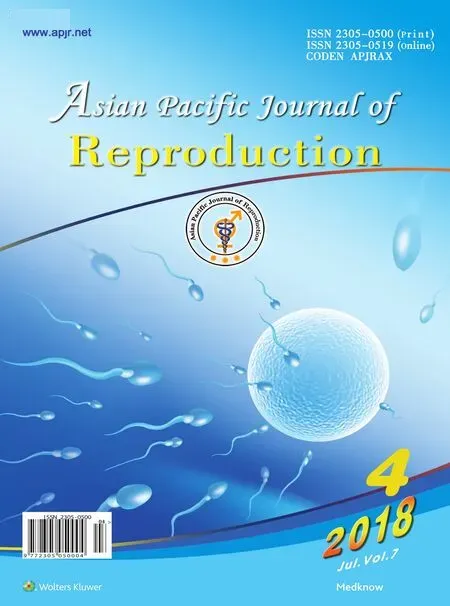 Asian Pacific Journal of Reproduction2018年4期
Asian Pacific Journal of Reproduction2018年4期
- Asian Pacific Journal of Reproduction的其它文章
- In vitro fertilization: Facts in medical sciences
- Functions of follicular and marginal zone B cells in pregnancy
- Treatment of cows with clinical endometritis Ⅲ as cows affected by pyometra-Non antibiotic treatment of severe clinical endometritis
- Consequences of unilateral cryptorchidism on semen and sperm characteristics in West African Dwarf Goats
- Increase in reproductive ability of high-producing cows, and qualitative parameters of their offspring, under conditions of intensive milk production
- Developmental competence of bovine oocytes with increasing concentrations of nano-copper and nano-zinc particles during in vitro maturation
